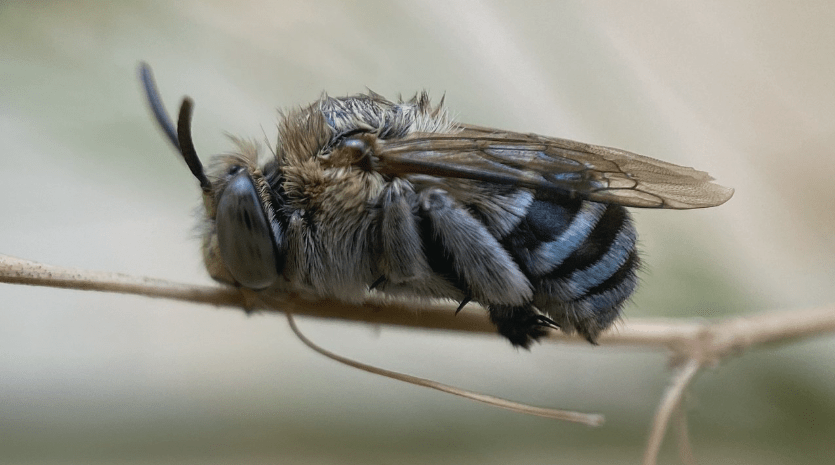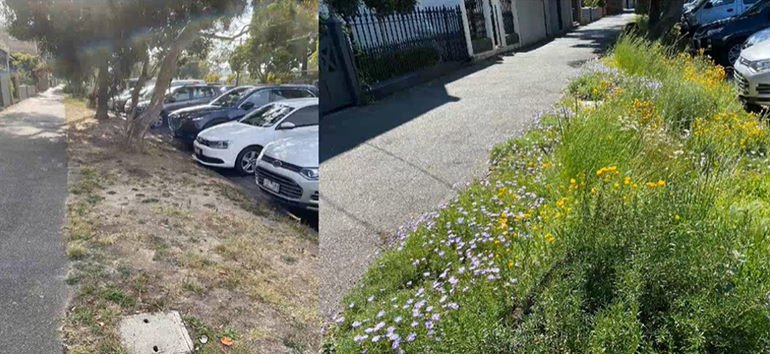Thriving in the ‘next economy’ requires designing for all of life, and caring for place, within social and ecological systems (Thakara, 2015). The Heart Gardening Project in Melbourne, Australia is one such example of the creation of ground up initiative for a “leave-things-better economy”. Founder, Emma Cutting, discusses how this community-led street gardening initiative has scaled up to its current focus, the Melbourne Pollinator Corridor, an 8km, community-driven, ecology-centred wildlife corridor for native pollinating insects in central Melbourne.

I first experienced the untapped goldmine of opportunity that is street gardening in 2016, creating and maintaining a tiny garden outside my rental. To me, street gardening is its own type of gardening -different to guerrilla, private and government plantings. This is the mindset and approach we use for all types of green public spaces. I define Street gardening as creating and maintaining a public garden (often by a resident outside their home) combining site awareness, observation and immersion with a particularly determined, caring, generous, positive and community-centred mindset.
I quickly realised it was a complete no-brainer to fill the many barren, under-utilised pieces of public and private land with beautiful gardens designed for biodiversity and that not only would these street gardens make our neighbourhood more beautiful, but they would address many enormous social, economic and environmental challenges AND have the potential to strengthen, deepen and build communities of humans, critters and plants.
Learning all of this, along with the fact that nature strips take up over 36% of public green spaces in Melbourne (almost 360 acres in the City of Port Phillip alone), I simply could not understand why street gardening wasn’t this huge movement and why nature strips (and so much other public land) was still being largely ignored.

Because street gardening helped me in so many ways, I wanted to share my approach and thinking with everyone and decided to give scaling street gardening a go.
The Heart Gardening Project is a startup which began in 2020, and already we have accomplished much, directly creating over 70 street gardens in central Melbourne, consulting with over 60 specialists and scientists, planting over 8000 plants, speaking to thousands of people around Australia about street gardening and changing legislation in City of Port Phillip council to enable street gardening to continue.
Our current focus is the Melbourne Pollinator Corridor (MPC), which will be an Australian-first – an 8km, community-driven, ecology-centred wildlife corridor for native pollinating insects connecting Royal Botanic Gardens Melbourne to Westgate Park.

After two years of designing the MPC, we are now in the creation phase and are aiming for 200 Indigenous-focussed gardens in the next two years. So far (early 2023) we have 13 gardens in and many sites on the go. We are also setting up our citizen science program, encouraging and empowering the community to create their own MPC gardens and working with local schools, residents, businesses, developers, churches and other authorities.
Through our approach, we are changing how people think and feel about urban wildlife and challenging how public spaces are designed, used and maintained. What we do captures many people’s imagination and enthusiasm and I love the questions we get. Some of the most common questions I get asked are regarding my background:
“What are you trained in? Are you a horticulturalist? Landscape architect? Ecologist?”
“No”, I answer, “actually, I am a piano teacher and a mum!”
Far from finding this a setback, being an outsider to the systems I am trying to create positive change in has actually been an asset.
In Part 2 Emma will elaborate on how being an outsider to a system has been an asset to her work in creating THGP and MPC.
Emma Cutting is Founder and Chief Doer of The Heart Gardening Project (THGP), a registered charity that combines community, science and care to joyfully connect humans to humans, humans to nature, and nature to nature through street gardening.
Pingback: Change from the Outside (Part 2) | Integrative Briefing for Better Design